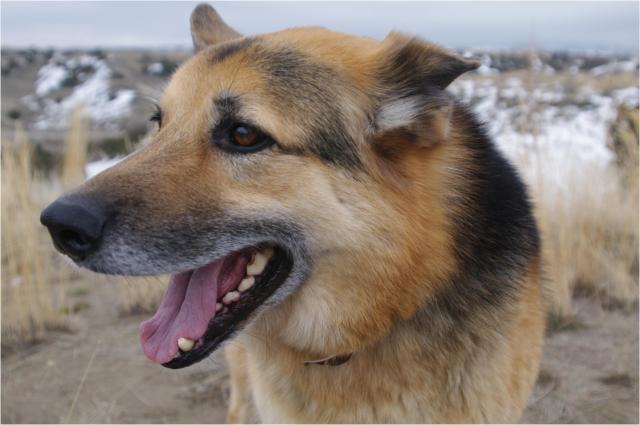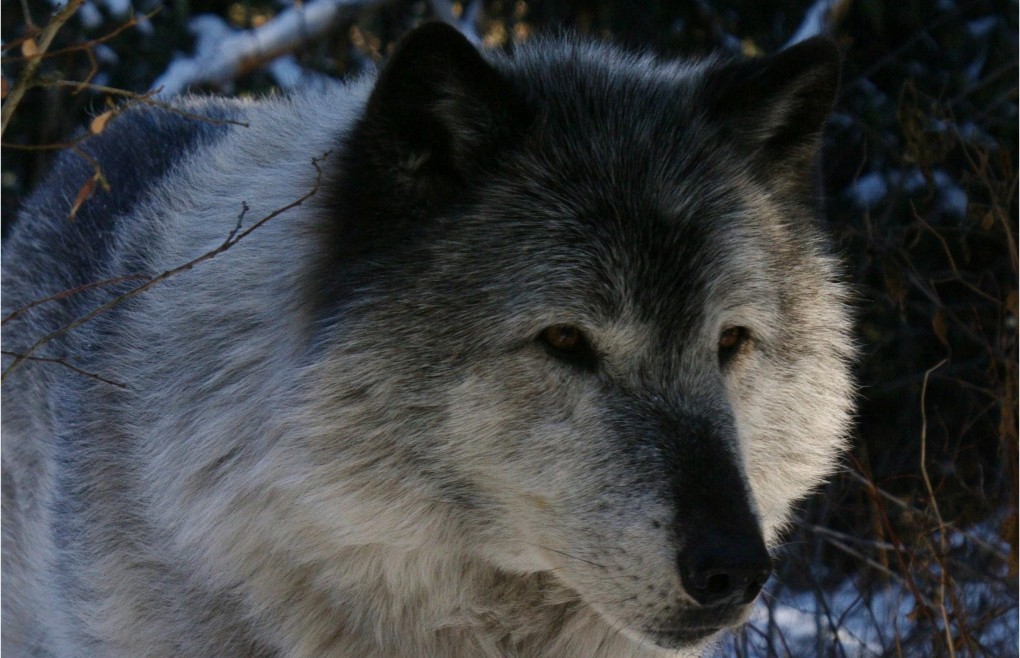A piece by Ralph Maughn back in 2006 with a letter by Jim Halphpenny discussing the economic impacts of wolves.
Corruption in Colorado?

Jim gave us a talk after dinner one night regarding some of his experiences as a master tracker. The first thing that he made sure we knew was that sixty-percent of wolf deaths are human caused. Forty percent of those human caused wolf deaths are from management removal.
Jim spoke about a wolf death that he was called down to Colorado to investigate. The wolf was found dead on the side of a highway in Colorado. It was presumed to have been hit by a large truck. This was the first wolf to be found in Colorado and caused much social concern ultimately demanding wolf management. High Country News even covered a related story entitled “Prodigal Dogs”, suggesting that wolves had returned to Colorado and were there to stay. Upon investigation, Jim and his partner Sue found that the wolf’s injuries did not match those of being hit by a truck. This had been a collared wolf but the collar was nowhere to be found. Jim and his partner hypothesized that the wolf had been shot in a different state, and the poacher dumped it on the side of the highway where it was found in Colorado.
The Colorado Division of Wildlife told Jim and his partner that they were not to discuss this case for a year. They complied. Why did Colorado Division of Wildlife require Jim and Sue not to discuss this? I don’t know. However, it undoubtedly has to do with people and not wolves. This was a human created problem when someone dumped a poached wolf carcass on the side of a highway. The problem was then escalated by humans when some Colorado citizens reverted to fear because of a lack of management for a species that probably didn’t even live in the state. Then, the human created lie was covered up, instead of addressed in an honest fashion, by the Colorado Division of Wildlife. This entire scenario was a human created mess surrounding an illegally poached endangered species which was strewn to the side of a highway in order to avoid lawful prosecution. When are we going to start looking at our own fear and how it escalates out of control instead of displacing it onto something else?
Someone illegally poached an endangered species and left it on the side of a highway with what appears to be a complete disregard for life. People do this to animals and people. This lack of respect for life is the true crime but when we are so caught up in our own human created dramas, it takes a while to peel back the layers to see things clearly, especially if the public does not have access to accurate information.
Jim Halfpenny
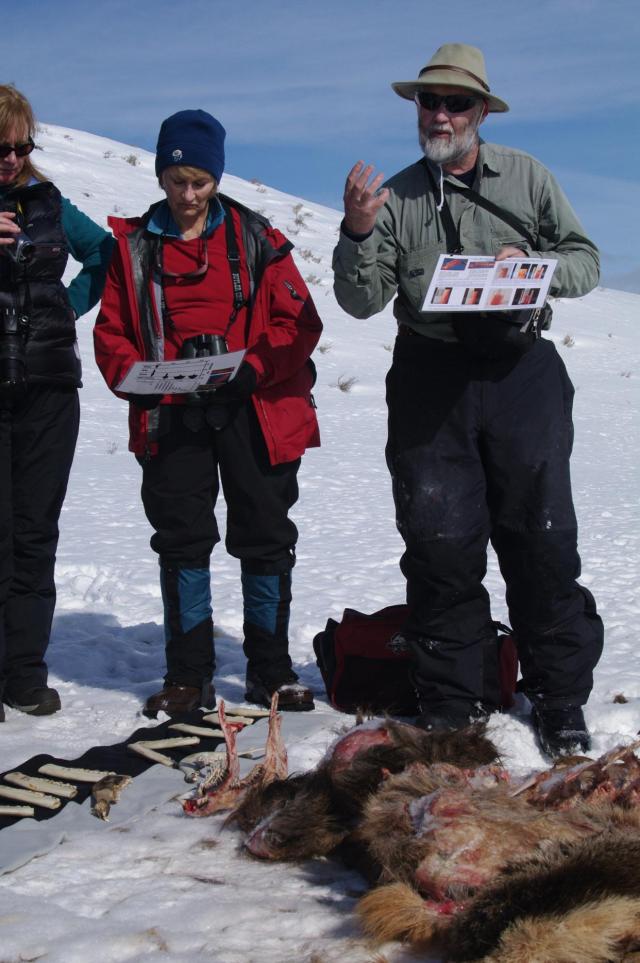
After getting our fill of wolves for the day, Jim Halfpenny PhD, one of the most highly regarded trackers in the U.S., decided to teach the group some basics about tracking. He took us about 10 yards off of the road and gave the group the story behind some wolf tracks. My idea of tracking had been to take a guess at what type of animal the track belonged to. After about ten minutes with Jim we knew how big the wolf was, how fast it was traveling, when it slowed down, and the direction in which it was looking. Very cool. After that he taught us how to make a cast of the print.
Then, we hiked into the site of a possible wolf kill. It was a dead cow elk. He rolled out his satchel of probably 15 elk jaws depicting different ages and stages of dental health. He estimated this particular cow to be around 5 or 6 years old and in relatively good dental health at the time of her death, which is not a thing to underestimate. As Jim put it, elk eat glass, not grass, all year long. Grass, as a means of protection, has evolved to incorporate some very sharp particles in it and can often lodge itself under the gum line causing all sorts of dental issues in ungulates that are unable to heal. Unfortunately I think Jim is as close to a dentist as the elk are going to get.
We weren’t sure what the cause of death was but we did see that she had a broken leg and her body was located in a bit of drainage at a patch of deep snow. This location implies that she could have broken her leg while trying to outrun her pursuer. It looked as if multiple animals had taken from the carcass which is very common for wolf kills. All and all this had been a very educational day!
“The Fierce and the Furry”
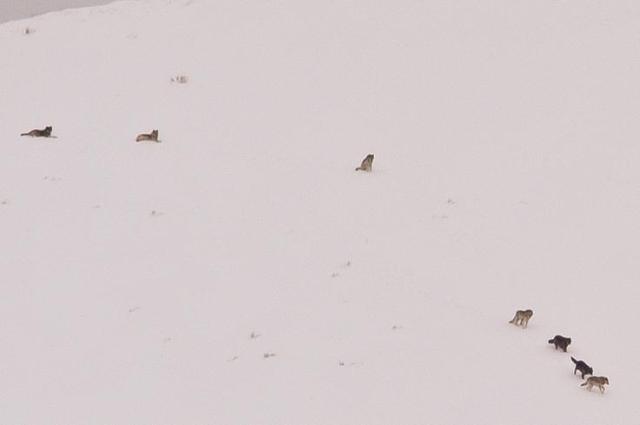
Today we got a peak at a pack of wolves first thing in the morning. I can’t remember which pack it was, but we did get to watch the pups play which was pretty fun. Actually, it made me miss my dog. I saw no difference between how dogs play and how wolves play.
I had heard about the mass following of wolf soap operas prior to my trip to Yellowstone. I find it interesting but just don’t have the time to keep up with it all. Regardless, the wolfy version of “The Young and the Restless” has gained quite the following, and rightly so. First off, the information is credible and gathered by the public, for the public. People who are independently motivated to learn more about the lives of Yellowstone wolves gather and disperse information, usually in the form of wolf sittings. The information is pooled together, via word of mouth and/or publications, and builds collectively amongst people interested in learning more about wolves. People begin to see the personalities of individual wolves and can relate these traits to the wolf’s lineage. Have you ever wondered where your dog came from and what his or her parents are like? Well following Yellowstone wolves gives people a glimpse at things like that. These wolf sagas simply grow as the lives of the wolves change. However, these creatures do continue to remain quite elusive, which is one of the things that keeps people coming back for more.
These wolf soap operas do seem to be one of the best ways to truly learn about this animal. Yellowstone Reports, run by Nathan and Linda, is probably the best way to get involved with, or keep up on, all of the new developments regarding the Yellowstone wolves, as well as issues pertaining to other animals in and around the park. Bison have actually taken the spotlight over wolves lately. Their massive, boney bodies are being captured and/or slaughtered as they leave the park in search of winter food sources at lower ground. Michael Leach, who spent the day with our group, wrote a short article about the bison issue in New West called Is Gardiner, Montana, the Selma, Alabama, of Wildlife Conservation?
A Shift in Outfitters
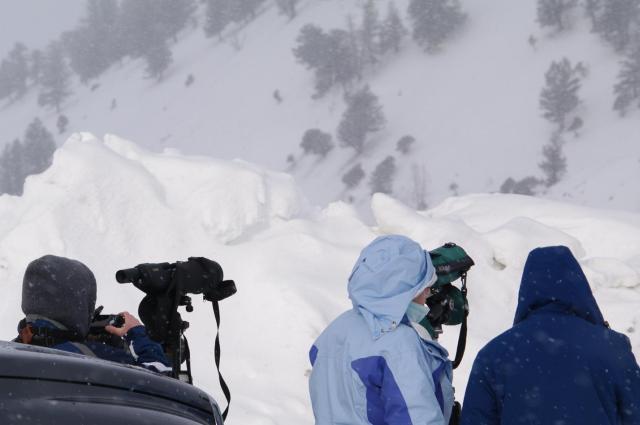
For the past few decades guided hunting trips have served to boost local economies in the greater Yellowstone area. Elk populations were at a record high, and thus, the hunting was good, really good. Hunting trips provide bonding experiences in, and with, the great outdoors in a capacity that many people no longer have the skills to facilitate on their own. Also, if it’s a good trip, you come back with a freezer full of wild meat and maybe some sort of preserved memento for a wall. With the repopulation of wolves in and around Yellowstone Park there has been a shift in the types of guided services that people are now interested in and have access to.
Wolf watching tours offer a different type of experience. People are not interested in making the kill themselves. Instead, they choose to quietly line the side of a cold wintery road with spotting scopes to watch the wolves do the killing, as well as anything else that a pack of wolves may do. These two groups of people, hunters and wildlife voyeurs, are not so different; both ultimately thrive on the lost lives of ungulates and many have an insatiable desire to learn more about wildlife. However, not being a hunter, I do wonder what human/animal connection is lost in not making the kill ourselves.
Outfitters are still around in the greater Yellowstone area but the nature of the guided experience that people are looking for may be shifting with the resurgence of wolves. One man in our group was on his sixth tour with the Wild Side. Another couple was from England on their third tour. The only reason they have ever come to the U.S. is to watch wolves. There was another woman from Scotland and multiple other people, in a group of sixteen, who were on their third wolf tour. Amidst this economic downturn, there are still people making money.
Off to Yellowstone
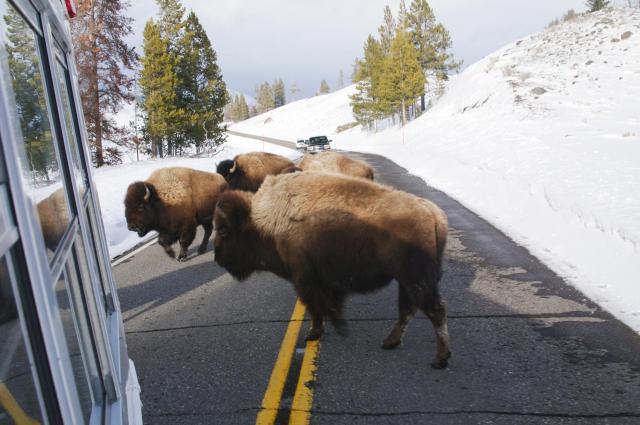
I got into Bozeman around midnight, the air was cool and the streets were slick with fresh snow. The hotel that I was staying at welcomed me with a lively bar and a buy-one-get-one-free drink voucher. I had indeed come here for a “wild” experience, but of a different nature, so I was off to bed. I had a long week ahead of me full of early mornings and long days packed full of unforeseen wolf adventures.
At some point last year I had decided that I was going to go on a guided wolf tour in Yellowstone. For two years I had been studying human conflict surrounding wolf reintroduction in Idaho for my master’s thesis. I decided to go out and get a glimpse of the beast in the wild for myself. I had no idea how much I would learn, and, the scope of the experts that I was about to be surrounded by. Yellowstone is undoubtedly the world’s hub for cutting-edge, biological and ecological, wolf research.
I choose a tour with The Wild Side run by Nathan Varley and Linda Thurston. Nathan is a Yellowstone native with his PhD in Biology. Linda has her MS in Biology. The two have worked on Yellowstone’s wolf reintroduction since its inception, and eventually got married. They seem to know everyone in the park, especially those who know where the wolves are at. Linda has done wolf outreach work with ranchers through Defenders of Wildlife and you cannot stump Nathan on any wildlife question, no matter how hard you try. Yellowstone wolf guru Doug Smith said that “he considers what these two are doing to be one of his biggest accomplishments” in a small intimate talk he gave our group one night.
Quotes!
Mom got me a book for Christmas full of gorgeous photos of wolves and quotes that are just as stunning. Thanks mom!
“Throughout the centuries we have projected onto the wolf the qualities we most despise and fear in ourselves.” – Barry Lopez
“The caribou feeds the wolf, but it is the wolf who keeps the caribou strong.” – Inuit Proverb
“The greatest threat to people is ignorance. The greatest threat to wolves is ignorant people.” – Anonymous
“We humans fear the beast within the wolf because we do not understand the beast within ourselves.” – Gerald Hausman
“If you live among wolves you have to act like a wolf.” – Nikita Khrushchev
“We reached the old wolf in time to watch a fierce green fire dying in her eyes. I realized then, and have known ever since, that there was something new to me in those eyes – something known only to her and to the mountain. I was young then, and full of trigger-itch; I thought that because fewer wolves meant more deer, that no wolves would mean hunters’ paradise. But after seeing the green fire die, I sensed that neither the wolf nor the mountain agreed with such a view.” – Aldo Leopold
“Ridicule is like a wolf: it only destroys those who fear it.” – Anonymous
“In wildness is the salvation of the world.” – Henry David Thoreau
“Perhaps this is the hidden meaning in the howl of the wolf, long known among mountains, but seldom perceived among men.” – Aldo Leopold’s Response to Thoreau
Another interesting article exploring American culture and wolves
Comprehensive article on Northern Rocky Wolf Reintroduction
For anyone interested in a comprehensive article on the Northern Rocky Wolf Reintroduction, including stakeholder interviews, please check out my article Lessons from Wolves that was recently published by Izilwane. Izilwane is a webzine (magazine on the web) that works to connect the human animal to the global ecosystem.

How Wolves Improve Our Waters
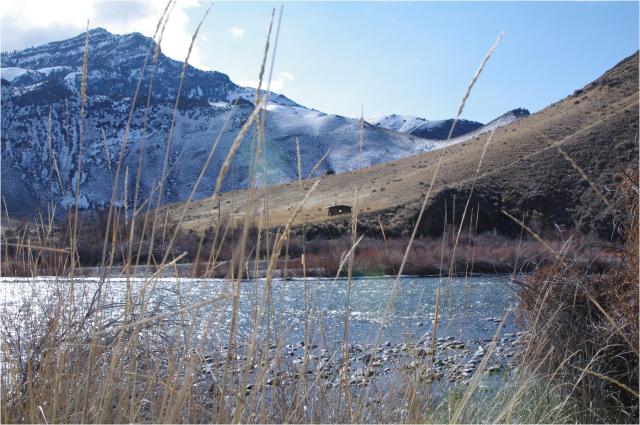
One of the interviews for my fieldwork was with a pro-wolf rancher’s wife, not an easy thing to come by. I’ll call her Bev. Bev’s family has been working the same Idaho land for 140 years, they are eighth generation. When first settling the land, their predecessors lived in caves on the property. Their history with, and reverence for, this large piece of arid land is difficult to describe.
A decade or so back, environmentalists, especially those focusing on water issues, began criticizing ranchers as well as policies which allow cattle to graze on public land. Riparian zones were being decimated. Riparian zones are areas along bodies of water that are dense with plants and trees, such as willow or aspen. They serve to filter water and control erosion which are fundamental for clean water and healthy habitat for fish, birds, animals, plants, us, ect.. Environmental groups like Western Watershed were/are concerned about cattle thrashing riparian zones. When Bev found out about these detrimental effects of cattle ranching she researched what her options were to take better care of their land, ultimately finding holistic land management http://www.holisticmanagement.org/. She has since restored riparian zones on their property to better than they were when she got there.
Bev started our wolf interview by recounting the mind-boggling amounts of massive buffalo stampeding the west a century or two back. Wolves ran, and hunted, these immense creatures (which is amazing in itself). By keeping these ungulates (hoved animals) moving, wolves protected the land from being overgrazed and prevented riparian zones from becoming lounging spots. Bev’s historical account coincides with recent scientific findings in Yellowstone N.P. showing significant improvements in riparian zones following the reintroduction of wolves. Bev believes that when this constant movement is mimicked in cattle grazing it is actually good for the earth. With frequent movement, cattle can’t eat enough grass in one place to damage root systems of plants. Strong roots usually make for strong plants helping to create firm land and thus clean water. Cattle also add, and mush in, a very beneficial amount of fertilizer (poop) to the earth; ultimately making the ground healthier than when they got there, if they don’t overstay their welcome. Bev and her husband now move their cattle between small grazing plots on a daily basis.
Beavers are another important part of the equation for clean water. An old family book written by Bev’s relatives’ documents the extensive beaver damns along the river that runs through their property. Bev says they haven’t seen beavers since fur trapping wiped them out last century. She feels that beaver damns played/play a large role in adding structure to the river. This structure slows, and controls, the flow of water, significantly reducing erosion, especially in riparian zones. Since the wolf reintroduction, Yellowstone ecologists have found more beavers, and beaver damns in Yellowstone. Beaver habitat has most likely improved because ungulates no longer lounge in riparian zones; it’s not safe with wolves around. Beavers can now return to their natural habitat and have materials to work with for building damns.
It is important to note that Bev’s family has not had any wolf encounters. This is an argument used against her pro-wolf stance. The predators they have dealt with are coyotes and rattlesnakes. Regarding coyotes, their practice is to take cattle that have died, for whatever reason, and leave them up on a hill behind their house. The coyotes eat the cattle there and leave their ranch alone. This has worked for as long as she can remember. Bev thinks that they understand and respect this notion of boundaries and territory. This makes sense if we stop to think about how coyotes, as well as wolves, exist within their own very strict boundaries. Rattle snakes are what really scared her. She used to find them on her back deck quite often. With time, she learned that they don’t want to strike and if you simply tap the deck behind them in the direction you want them to move, they do. If Bev and her family do experience wolf depredations, she feels that it is appropriate to have the option to use lethal measures, but only if necessary.
Bev looks forward to the lessons in land and water restoration associated with the reintroduction of wolves. A huge, yet unusual asset is her ability to use her family’s historical knowledge to find ways in which they can live harmoniously with the land and all of its creatures. It is her duty is to protect these things and ensure that they are intact, if not better, for generations of her family to come.
There are not many people around like Bev and her family anymore. In this regard, you could say that Bev’s culture is somewhat endangered. Darrell A. Posey (1996) discusses the parallels between cultural and biological destruction. Countries rich with biological diversity are usually accompanied by indigenous peoples that manage, maintain, and defend the land against destruction as a means for continued survival on natural resources. Indigenous people’s roles in conserving biodiversity have been consistently underestimated due to a failure to recognize co-dependent relationships between humans and nature. This is often due to a ‘language barrier’ between science and indigenous knowledge; it is hard to document historical knowledge of nature. However, scientists are discovering that what they thought were wild areas, are actually the products of co-evolutionary relationships between humans and nature. In other words, we are doing good things too, we just have to find them.
Following an amazing interview, this family’s hospitality blew me away yet again when they offer me a bed to sleep in that night. I declined as the German Sheppard in my car might wreak havoc on their cattle and I needed to return to my computer. While finding my way back to town on dirt roads, I realize that I need to make a u-turn. As I do, a little girl no older than eight walks out of her house and yells to me “go away, we don’t want you here, this is our town, leave us alone.” The contrast is shocking, but not surprising. I’m just a girl in a subaru, harmless, imagine if I were a wolf?
Dead Wolf Pup
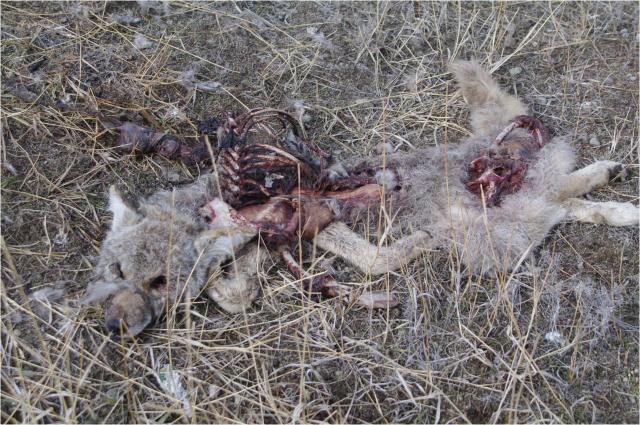
Here’s the dead wolf pup Trooper found. We had stopped on the side of the road to check out an old homestead. Seeing this carcass made me think about how hard it is to actually count wolves. This little guy was most likely never accounted for, maybe never even seen by anyone besides us. Really, it’s hard to say how many wolves are out there. Scientists do their best, but really, there is only so much they can do. It is important to remember that science does not know everything. It only tries to.
Wolf Country Hot Springs
One of my favorite activities is a day in an Idaho hot spring. Hot springs are everywhere in the gem state, the majority of which are very remote. So while driving from Challis to Salmon I decided to stop for a dip. The dip required a 7 mile hike total, and was remote. I decided to stop and talk to the ranger in Challis before I embarked upon any solo hot springing. I specifically asked her about wolves. Afterall, this was wolf country; this was where they were released, and this is where they continue to reside. My biggest concern was for my dog Trooper. He likes to run off and explore all of the many sents that the mountains have to offer. She smirked a little and assured me we’d be fine.
During our journey we encountered no wolf threats. However, Trooper did find a dead wolf pup at a pit stop. I enjoyed a beautiful day and a phenomenal soak in an amazing cascade of hotsprings following a sweaty spring hike. During the hike, I was not afraid. The path belonged to humans and animals know this. Generally, the thing to fear most is other humans. I did keep Trooper close to me however as I know that his saftey is a legitimate concern while in wolf coutry.
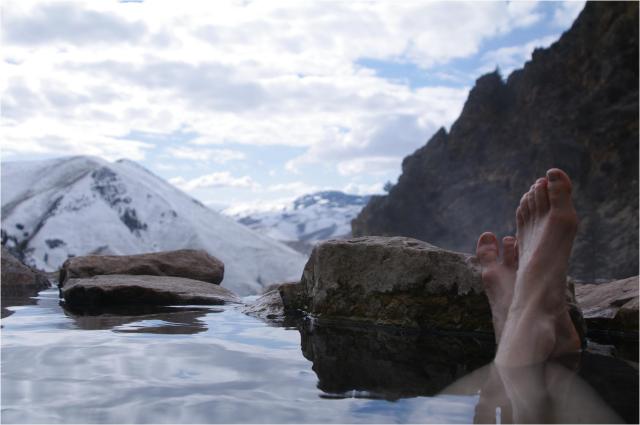
The Value of a Wolf
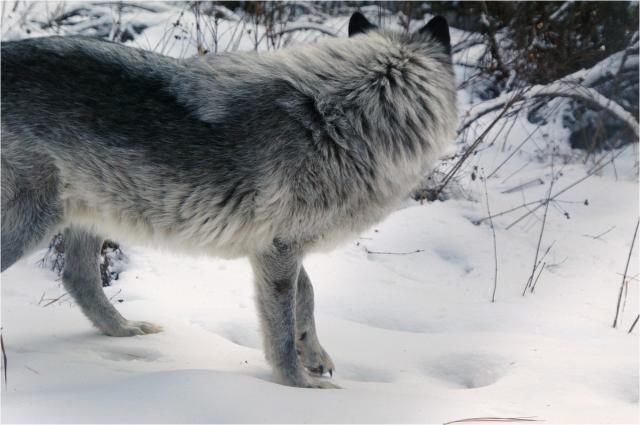
Here’s Piyip again from the WERC. I’ve got lots of photos of him as he was such a friendly boy to me during my stay there (even giving me a bit of a photo shoot one day). This picture was taken in early December and gives people an idea as to just how thick a wolf’s pelt, or coat, is during the winter. Piyip is probably older than any wolf surviving in the wild, and most of us know from our own dogs that their coats change as they grow older; losing luster and shine. However, Piyip’s coat, or should I say mane, is still pretty impressive. If he were to let me put a ruler perpendicular to the skin on his neck, his fur would probably measure out 5 inches. I guess you need a coat like that for those sub zero days and nights.
A wolf’s winter pelt is a valuable commodity to some people. The Nez Perce (whose reservation is located in central Idaho) use winter pelts for cultural ceremonies. To them, the pelt is the only reason to hunt a wolf. For many non-native Idahoans there is no perceived value in having wolves. The death of a wolf is what is valued. At the local gas station in Winchester, Id., there was a photo of a wolf that a man had killed. It was posted on the wall along side many other photos of trophy wildlife killed in the area, such as elk, cougar, ect.. The photo of the wolf caused all sorts of public outcry. One of the main complaints was why did this man claim the wolf? In other words, he should have tossed the carcass over a cliff and tried to kill another with his existing hunting tag. Or, just ‘shoot, shovel and shut-up’.
The value placed on wolves differs greatly among groups of people. These values have much to do with the ways in which cultures are constructed, and thus, cultural constructs; ‘how does this animal benefit our way of life’. How can/does the wolf benefit people that see it as a varmint and threat? I’d love to know. Any thoughts
He sees you, can you see him?
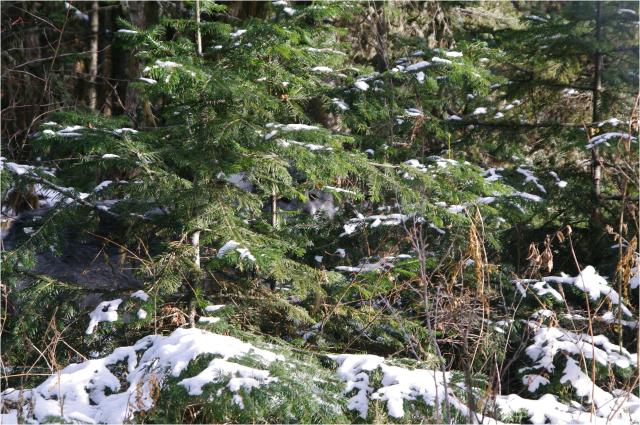
It amazes me how well wolves manuver the forests without being detected. Piyip was walking with me just a few feet away yet disappeared into the forest with ease; it’s what he does as a wolf (sometimes rather clumsily though). This ability to become an illusion is an attribute of the wolf that has both mystified and terrorized people for millenia. This is just another way the wolf has been able to elude us, serving as a reminder that we are not in control.
Piyip
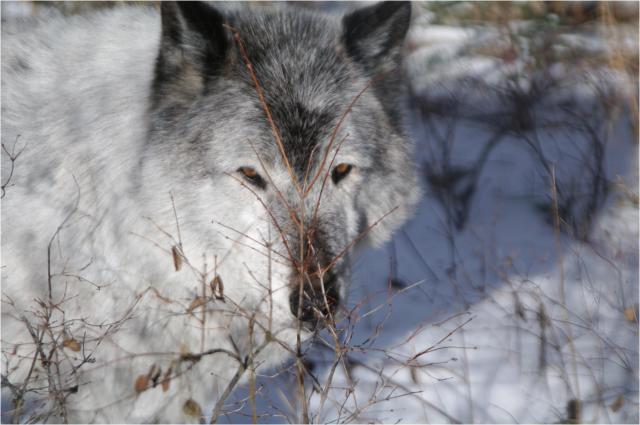
Omega of the Owyhee’s
This is the omega wolf of the Owyhee pack at the WERC. Can you see the dark spot on her hind quarter? This is where the pack ‘beats her up’, or bites her, to remind her that she is the omega. For an omega her lashings are VERY mild, especially for captive wolves (which she is). Captive wolves are usually much harsher on the omegas. This is partly due to a captive pack having more anxiety to take out on the omega, as well as the omega not being able to escape as a wild wolf might. It is important to remember that every pack of wolves has a unique social dynamic, and with every pack, an omega wolf can become an alpha, and vice-versa.
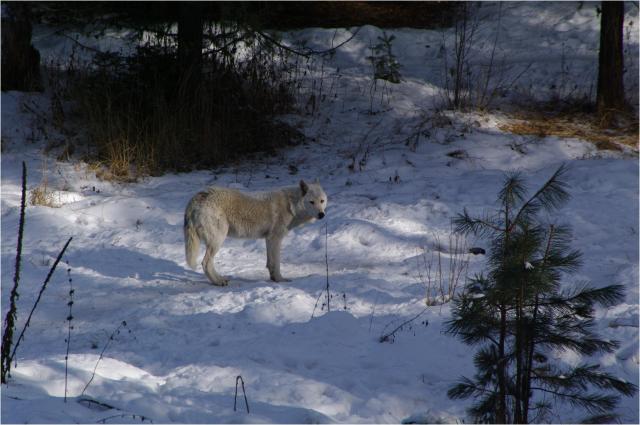
Wolf Travel
Can you see both wolves? They are traveling, as a team. These two are captive wolves but live in a 20 acre enclosure. As you can see, they travel together, but pretty far apart. A pack of wolves covering territory in the wild will often travel a mile apart from one another. Can you imagine how keen their senses must be to maintain contact with the rest of the pack!
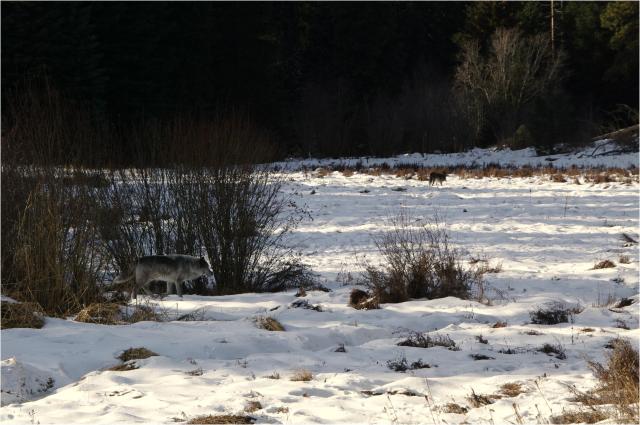
Piyip
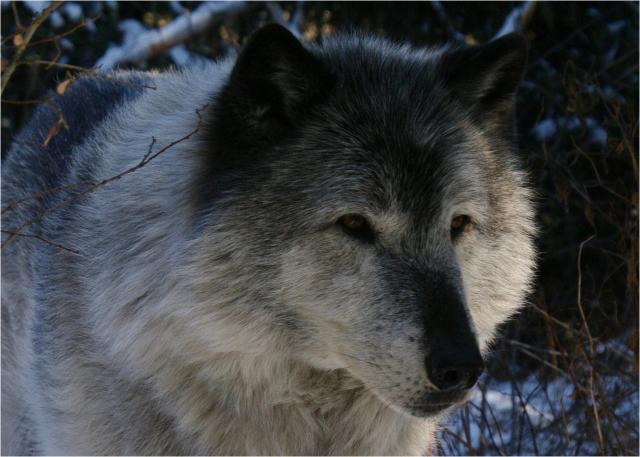
This handsome guy is Piyip. At 13 years old, he is about as old as a wolf gets. He is now the sole surviving member of the Sawtooth Wolf Pack; living out his final, somewhat lonely days, at the Wolf Education and Research Center (WERC) in Winchester, Idaho. Piyip has led a very unique life as a wolf and has served to educate many curious humans. He is far from a pet, but, comfortable with some people if they speak a little wolf.
People, Wolves, or Both

With all of the hype around wolves in the northern Rockies it has become painfully obvious that the problem is far larger than just wolves. Conflicts of interest among groups of people create the most noise of all. We hear those with the loudest and most passionate cries, both for and against wolves. Science is usually used to support or negate these cries. What results is a fire that feeds the polarization of opinions separating groups of people. We end up with a scenario looking something like genocide, or, in this case, speciesocide.
I am by no means ascertaining that wolves are currently being eradicated to the point of extinction, we already did that once. Hopefully we are beyond eradicating, reintroducing, then re-eradicating. Hopefully. Yet the scenario does take on a bit of a genocide-like character. Groups pitted against one another in fits of uncontrollable rage and the use of lethal force carried out by the government.
Social sciences have typically been seen as the ‘soft’ sciences and somewhat dispensable, although, there seems to be a rising need for them. It is only recently that we are making use of social scientists in broader settings; one example is war (which is controversial). Anthropologists in Afghanistan have found that soldiers get better responses from local people, and thus more information, when they greet them with an appropriate greeting, opposed to using scare tactics. This is of course situation specific as there is rarely a finding within the social sciences that is universal, part of the reason for the ‘soft’ reputation.
In the case of wolves in the northern Rockies we could use some social science on the scene. Who knows, maybe we can even shed some light onto this extreme and mysterious relationship between people and wild canine’s. Or, better yet, help to serve some people who are actually on the ground with them and affected by their presence. People in these communities need to feel supported, and support comes in many forms.
A Bit on the Ranching Perspective
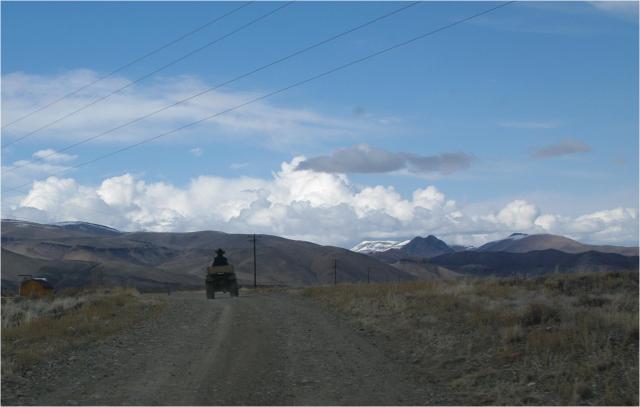
The wolf seems to embody all that is extreme, and thus, brings out the extremes in extreme people. The media likes to discuss these extremes because they make good stories. Quiet people with opinions about wolves stay quiet to avoid the noise. All this noise, is it really all about wolves? In conducting interviews in central Idaho for the fieldwork portion of my thesis, I found myself wondering which problem is truly larger: opposing interest groups regarding wolves, or, actual wolves. Who creates more problems: the people or the predator?
I asked a prominent Idaho rancher this question in an interview. As we gazed out of the back window of his home, he pointed to the exact location where wolves were first released, just past his grazing cattle and beyond two mountain peaks. This man has encountered many wolf depredations on his cattle and feels that our predecessors knew what they were doing when they eradicated this predator. Yet he answers my question without hesitation, “people”. People in opposing interest groups have undoubtedly created more problems for him than wolves have. In a separate instance regarding the same question, a woman working for conservation efforts known to actively protect wolves in central Idaho writes to me saying that she has “never seen an issue bring out the worst in people like wolves do”.
The rancher mentioned above has experienced extensive harassment over the past few years. He has had certain conservation activists’ howl at his grazing cattle with the intention to spook them. At one point, someone opened one of the gates to an enclosure where his cattle were grazing and spooked them right out onto a highway in the night. The rancher recognized the car that was parked nearby and was almost positive he knew who did it. After his daughter and son-in-law were followed home one night from the ranch they decided ranching was not for them. “As if ranching isn’t hard enough already”, he says.
Problems caused by actual wolves don’t seem to be so much about the money lost due to wolf depredations as it is about not being able to protect their cows from grueling deaths. Wolves don’t go for an immediate kill. They wear the animal down by running it and often eat it while it is still alive. Ranchers watch over their cattle closely, investing long hours of their days to these animals. On most ranches, the cattle are the first thing you see out your window in the morning and the last thing you see out your window before dark. Choosing to ranch is far more than a financial investment; it is an emotional investment in a lifestyle, family, animals and a home, hopefully for generations to come. It is a threatened culture. For ranchers that care for their livestock the way they should, not being able to protect their cattle from this type of death hard to bear.
Many ranchers that focus on quality feel as though their way of life is endangered, and they have lost a big battle with the wolf reintroduction. The cattle industry, in general, has been under attack for its inhumane practices and poor quality of product. Smaller ranches that take good care of their livestock, as well as the land, have trouble competing with large corporate type ranches who require specific husbandry practices that ultimately diminish the quality of life for everything (but this is an entirely separate issue). As if this isn’t enough, some conservation efforts go so far as to support wolves simply as a way to move ranchers off of public land. This skillfully displaces anger onto wolves, although, hatred toward this predator is not hard to come by, especially from ranchers.
The idea that the wolf is nothing more than the thug and the thief of the forest is more prevalent than the predator itself. Wolves are apparently everywhere killing everything; wiping out all other animal populations while their own numbers continue to grow. A friend of mine who works for the forest service out of McCall, Idaho was a bit weary of my intentions at first, possibly pegging me as another wolf fanatic. He later opened up saying “people say they’re everywhere, but no one ever sees any.” This is of course part of the problem; they are hard to catch, but definitely something to think about.
Conservation
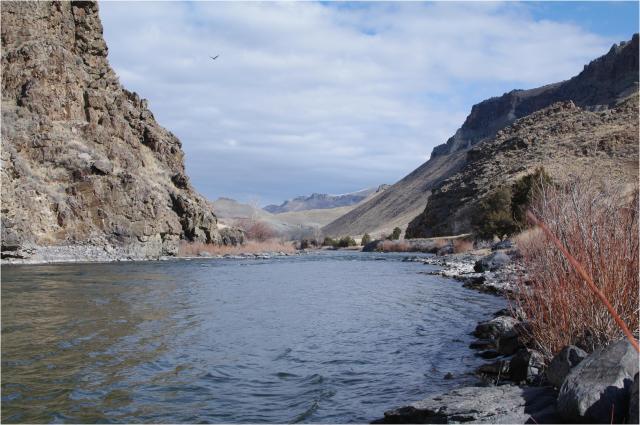
I don’t like the word conservation because it doesn’t include people, or their culture for that matter. It insinuates that people are messing things up. I don’t think this is a healthy approach.
Conservation has historically imposed hard science, and just like anything else, this includes both positive and negative effects. These effects are both environmental and human oriented. Many of the positive effects of conservation are things we all take for granted, like Yellowstone or Yosemite. I am proud of my heritage and feel a much deeper connection to where I am from because of reserves like these. It is important that we continue to foster a connection between people and the natural environment in which they are from.
I am deeply thankful to call the west my home, where nature is still wild and a somewhat endangered culture supports this lifestyle. The voice of conservation should be thanked for these things but, too often this is not the case. Seventy-five years past has turned into ancient history for mainstream American and land use has become compartmentalized thus detaching many from the section of the earth in which they are from.
We have reached a point where culture needs to be integrated into this idea of conservation, and will thus strengthen both. Conservation efforts do seem to be making a jump in the right direction. Groups like defenders of wildlife devote much of their efforts to working with local people. Their efforts in Idaho around the 1995 wolf reintroduction are commendable. They are devoted to working with groups who oppose the wolf, such as ranchers and hunters, to find ways to coexist. In the past 15 years they have given over a million dollars to ranchers for lost livestock due to wolf depredation.
Conservation efforts should be pushed to find the ways in which local people live harmoniously with our earth. Build alliances with the people who live with the land and possess great knowledge that science does not always understand. There are sustainable practices out there and when we find these practices we reinforce positive cultural relationships to the land and grow from there. Let’s use science and traditional ecological knowledge to strengthen our relationship to the earth. Many times these practices are very much ‘out of the box’ for conceptual conservation; little gifts given to humanity when we choose to stop judging others.
Civilization
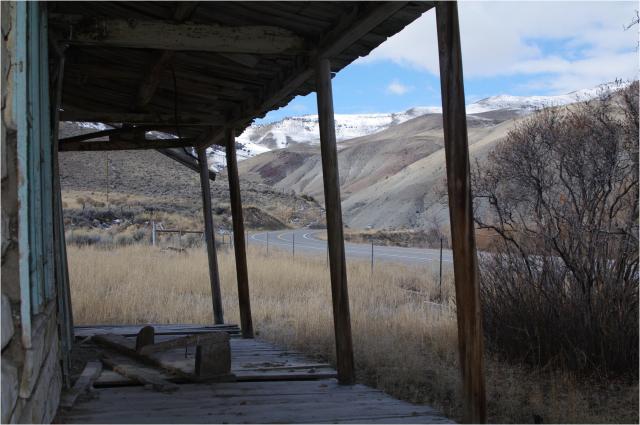
Civilization, what an interesting word; one definition of civil is ‘in accordance with organized society’ and the most popular synonym is ‘polite’. In my limited reading, most actions taken to reach civilized societies are in fact not civil at all, especially when one takes into account the environment and other peoples. Once societies achieve civilization, there must be acceptable outlets for uncivilized behavior (anthropologists might call it counter culture). If people don’t have these outlets, people find many ways to be uncivil.
To be civilized is to gain many things. I really like all of my electronics these days. However, with something gained, something is always lost. Through civilization we have lost touch with a wild aspect of human nature. Sure there are many ways to find it again, but, you must seek it. Or, learn about it rearing its’ ugly head. Are humans really civil? If so, how often? What do we miss out on in trying to be civil? How can we find that again?
Heading East to Pocatello
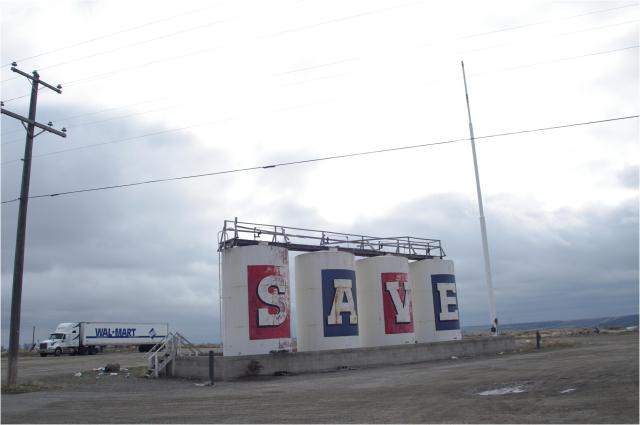
Today I’m in Pocatello and am reminded of a general disrespect for space, environment, and even self found in many places throughout America. I went to a sauna at the Ramada Inn (where I am staying) and there were cigarette butts, beer cans and the shells of sunflower seeds inside. One can only imagine the amount of trash (which is a lot) on the neglected grassy noles that serve as landscaping outside. The natural landscape is surprisingly beautiful as Yellowstone N.P. creeps closer and closer. However, the upkeep of the town is surprising in contrast where beer cans and cigarette butts are found anywhere and everywhere. I am constantly walking past trash on the ground but don’t stop to pick it up, as I normally would, because it seems hopeless. Granted, this is a college town but I have been to plenty of clean college towns. Socioeconomics probably comes into play; less money, less energy to spend on your surroundings. That’s probably stretching it a bit though. What’s this got to do with wolves? I don’t know. It’s definitely got something to do with natural resource management and respect for the land and self. This much smoking and drinking can’t be healthy. If people struggle to take care of themselves that is what they focus on, not engaging in their environment.
